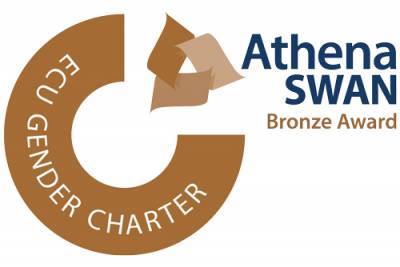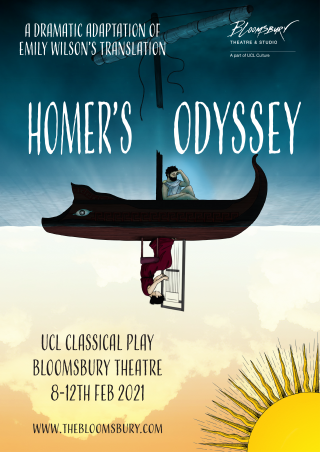
Lectures
Translating the Odyssey; in conversation with Prof Emily Wilson
Visualising Odysseus and his journey: cinematic approaches to the Odyssey (Dr Antony Makrinos)
Dead Men Talking (Prof Barbara Graziosi)
Short Videos
Why Homer's Women Matter Now - Retelling Homer's Women In Fiction (Dr Emily Hauser)
The Homeric Map of London (Dr Antony Makrinos)
Odysseus, A Philosophical Hero (Dr Nicolò Benzi)
The Epics of Endiku (Ahmed al-Ameen)
Essays
- When the Odyssey came to Rome (Prof Gesine Manuwald)
That Homer’s Odyssey became an influential text in Greek culture and its author so established that Homer could simply be called ‘the poet’ in Greek literature is well known. What is perhaps less well known is that Homer’s Odyssey also played an important role in the development of Roman literature. The reasons why this aspect has found less attention are mainly that the key pieces of textual evidence only survive in fragments and that in some periods of scholarship this process was regarded as secondary and met with less interest. However, it is worth looking at the transfer of the Odyssey from Greece to Rome as this process can reveal a lot about the relationship between Greek and Roman literature and the emergence of the latter.
In fact, a Latin version of Homer’s Odyssey is probably the oldest piece of formal Latin literature (beyond inscriptions, songs etc.), and this detail constitutes a key characteristic of Latin literature that makes it unique. For most national literatures emerge when a preceding oral, non-scripted culture, in which stories are told, goes through an evolutionary process and thereby becomes scripted when narratives get written down. While there was an early pre-literary culture in Rome, this was not what became literary. Instead, Roman literature appeared rather suddenly, as it were, when Rome’s first poet composed Latin versions of Greek texts (an epic, tragedies and comedies). Such a start was only possible since by the time formal Roman literature began, Greek literature was already well developed and established and Rome looked to Greece as a cultural model, so that Greek cultural achievements became a starting point for the Romans to develop their own literature, arts and sciences. Thus, Roman writers were able and willing to transpose literary texts available ready-made in Greece. The Romans were thus the first people in Europe to shape their own culture on the basis of another, fully developed European culture (and this function as intermediaries has become important for the later development of literature, arts and culture in Europe). Additionally, the first ‘Roman’ poets were actually Greeks by nationality, who spoke at least Greek and Latin fluently (sometimes besides other local languages) and were familiar with Greek literature; therefore, they were in a good position to transpose and adjust the material for Roman audiences. Moreover, there was a general acquaintance with the Trojan myths in Italy when Roman literature began to emerge from the third century BCE onwards, so that writers could build on a shared general background.
Rome’s first known poet was L. Livius Andronicus (c. 280/270–200 BCE). Like most early Roman poets, Livius Andronicus was not a Roman by birth. As the name suggests, he was of Greek origin and then came to Italy and later to Rome, perhaps initially as a slave. Thus, he must have been fluent in both Greek and Latin and familiar with Greek literature. Livius Andronicus wrote an epic as well as comedies and tragedies, inspired by the Greek model in form and content. He was commissioned to produce a drama or dramas for a public festival in 240 BCE, celebrated straight after the end of the First Punic War (264–241 BCE); this festival included dramatic performance and was also meant to demonstrate Rome’s cultural ascent.
Livius Andronicus’ epic might have been written just before this date and been the piece of work that recommended him for the commission to write dramas. His epic is entitled Odusseia: this expression is an old Latin version of the word Odyssey and thus shows this epic to be a Latin version of Homer’s Odyssey. It is widely assumed that Livius Andronicus selected Homer’s Odyssey rather than the Iliad as the basis for the first Roman epic because the story is more exciting (since it is not just a description of an extended battle, but rather offers travels and visits to a number of interesting places), because it is more relevant to Romans as Odysseus travelled to sites known to Romans and important for them and because the epic concerns homecoming.
There was a period when Roman authors were thought to be mere translators and not very creative, original or innovative. However, as has now been realized, Roman poets, even when building on Greek models, did not simply ‘translate’ the originals, but rather modified and adapted them according to their own ideas and the interests of the Roman public and thus created something new on the basis of the existing model.
At any rate, Livius Andronicus’ Odusseia is not a straightforward translation of Homer’s Odyssey: it was at least significantly shorter and probably placed the emphasis differently. The fragmentary state of the text makes it impossible to discern any particular ‘Roman’ interpretation of the story; where comparison is possible, it is obvious, though, that Livius Andronicus made significant changes to details.
For instance, from Livius Andronicus’ version a line belonging to the story of Circe survives, relating to the incident that Odysseus’ companions are turned into swine and then back into humans. The Latin text says (Liv. Andr. Od. F 25 FPL4), in English translation: ‘with all speed she made them into men as they were before’. This line corresponds to the Greek (Hom. Od. 10.395–396), in English translation: ‘and they became men again, younger than they were before, and far handsomer and taller to look upon’. If one compares the two statements, it is clear that the main event described, the transformation of the men, is basically the same while the nuances are different: in Homer the men form the subject, in Livius Andronicus Circe is the agent, whereby she and her magical faculties come more to the fore. Moreover, in Livius Andronicus the transformation is merely reversed while in Homer the men become younger than they were before. The reason for these changes in Livius Andronicus’ version is difficult to determine in the absence of any context; some people have thought that the original version might have been too fanciful for the more practically-minded Romans. What is obvious at any rate is that Livius Andronicus adjusted the story (since it has to be assumed that he could have produced a more literal Latin equivalent of these lines if that had been his aim). With this version he introduced the epic format to Rome, which was soon taken up by successors, who, however, made the content more Roman (writing about Roman history).
It is unfortunate that Livius Andronicus’ version of the Odyssey only survives in fragments. Yet it is clear that a Roman version of Homer’s Odyssey stands at the beginning of Roman literature and marks the peculiar beginning of this literature. Thus, the Odyssey is a foundational text not just for the ancient Greeks, but also for the ancient Romans (and still of interest today).
Study questions
What does the fact that Livius Andronicus chose Homer’s Odyssey as a model for the first Roman epic reveal about the status of the Odyssey in the ancient world?
What is the difference between a modern English translation of Homer’s Odyssey and the Latin version by Livius Andronicus?
To what extent might looking at the afterlife of Homer’s Odyssey in Rome might help us gain a better understanding of the original work?
- Heroism in antiquity and modernity:
from Achilles to Superman and from Odysseus to Batman (Dr Antony Makrinos) According to a modern definition of heroism, a hero is a person who is admired by many for his noble qualities and his bravery, or a chief male character in a story, poem, play. In modern times, a hero is someone who steers general admiration by actions that are meant to protect us and contribute to the well-being of the community. But are we sure that the word “hero” has got the same meaning in the Homeric world?
There is no doubt that in the Mycenaean years, there have been bards who sang the tales of heroes with the accompaniment of a lyre in private parties of male audiences. Later on, we have evidence that these stories have also been performed in more public festivals such as the Delian or the Panionian festival (something like the Eurovision contests of the time). Under the auspices of the god of music, Apollo, singers gathered to compete with one another and immortalize the glorious deeds of heroes whilst also gaining glory for themselves.
Immortilisation through art was one of the main purposes of heroism in the Homeric epics and this is evident both in the Iliad and in the Odyssey. For example, when Helen represents war in her tapestry (Iliad. 6.357-8), she suggests that Zeus himself has engineered her affair with Paris so that “in time to come we may be a poet’s theme for men of the future”. After the death of Patroclus, (Iliad 18.98-121) when Achilles laments and swears vengeance from Hector, he says: “let me die… For not even mighty Heracles escaped death… so too shall I… be laid in death: now let me win fine glory”. Similarly, Hector’s decision to attack Achilles aims to immortalise his name (Iliad 22.304-5: “let me at least not die without a struggle, inglorious, / but do some big thing first, that men to come shall know of it”). Finally, Odysseus prays Apollo to be granted glory when aiming his sharp arrow straight at Antinous and thus initiating the killing of the suitors (Odyssey 22.7-8).
In both of Homer’s epic poems, there are many repeated story patterns that invite the heroes to prove themselves and perform heroic deeds: the devastation of the hero which is followed by his withdrawal and eventually his return; the loss of a friend and the seeking of revenge; the quarrel between heroes; the rescue, wounding and killing of a hero; contests and duels, and the demonstration of excellence in war. All these thematic patterns invite the heroes to use values that are part of their core ideology. But which are the essential values that a Homeric hero needs to possess in order to be justifiably called a hero?
The definition of heroism is clear in both the Iliad and the Odyssey: a Homeric hero is someone who displays nobility at a human level and is of divine descendance. All heroes are kings and princes who are related in one way or another to the gods. They all have superpowers that relate to their physical beauty, speed, strength, a sharp mind or rhetorical persuasion. The two main protagonists of the Homeric epics possess epithets that prove these qualities: Achilles is “divine”, “godlike in appearance” and “swift-footed and Odysseus is also “divine”, “of many ways” and “cunning”. Furthermore, all Homeric heroes are wealthy, and they have the ability to govern and lead an army whilst at the same time taking political decisions that seal the fates of their men (and many times of their women). On many occasions, a hero is constrained by a god or by factors that are beyond logic, but not by space, time, season, weather or superior numbers. The Homeric hero possesses some invulnerability to illness when compared to common soldiers and he has the ability and courage to win glory through the achievement of impossible tasks at the risk of his own death. His relationship to death is unique and complicated: he acknowledges his mortality and may at times be afraid of death but also sees an opportunity in war that can offer him immortality. Heroic ideology and the pursuit of glory presupposes human mortality. The heroic code is a code of superiority which recognises honour as the immortal element of the hero.
All this does not mean that Homeric heroes do not make mistakes or that they do not misjudge situations. On the contrary, many times in the epic, they make a difficult decision for which they will have to take responsibility or even pay the price with their own life: Achilles’ misjudgement leads to Patroclus’ death, Hector’s sense of duty will cost him his own life, and Odysseus’ curiosity in the Cyclops episode will result in losing many of his men. The audience pity the hero for these mistakes because they recognise them as their own.
I will now turn to a comparison between ancient and modern heroes. Umberto Eco in his article on The myth of Superman suggests that “Superman is myth on condition of being a creature immersed in everyday life, in the present, apparently tied to our own conditions of life and death, even if endowed with superior faculties”. In other words, our heroes carry our own emotions, anxieties, dreams and hopes for the future. Achilles and Superman are both ‘super’ powerful because we would like to attain that power. They both have divine lineage, they are both handsome and have the ability to change politics sometimes through the use of violence, and they are both lonely heroes. Their invulnerability is also characterised by a weak point: Achilles’ heel and the kryptonite. They both need to have a weak point, otherwise they would be gods and we would not so easily be able to identify with them. But they also have differences: Achilles is an individualistic hero (but still a hero!) who cares for his own glory and immortality whilst Superman cares for the common good of the citizens of Metropolis. In the Iliad, there is no moral evaluation of good and evil protagonists whilst in the stories of our superheroes it is easy for an audience to distinguish between good Superman and evil Lex Luthor, good Batman and evil Joker and so on. It is really astonishing that this kind of moral evaluation does not exist in the Iliad, whilst it is absolutely necessary in the Odyssey (good Odysseus versus bad suitors, Cyclops, monsters etc.). It is for this reason that many commentators both ancient and modern have been eager to characterise the Odyssey as an “ethical epic” and it is interesting that this distinction becomes essential in the lives and deeds of our modern superheroes and villains.
Although Achilles does not have a double identity like Clarke Kent or Bruce Wayne, there are other Homeric heroes who do. As far as identity and the topic of justice are concerned, Odysseus and Batman are parallel cases. Odysseus is forced many times throughout his adventures (and especially in recognition scenes) to lie about his identity. He lies to Eumaeus, Penelope, Laertes, even Athena about being someone else. Odysseus knows by the end of the Odyssey how to protect his real identity in order to survive. Bruce Wayne does the same in order to hide the identity of the superhero to whom he refers many times in a joyful way. Odysseus takes justice in his own hands and punishes the evil suitors who threaten to steal his wife, his throne and his world and kill his son. He has been let down by Ithaca and its citizens in the same way in which the Dark Knight is let down by the citizens of Gotham and they both pay the prize for being heroes: Odysseus loses himself, his identity and his companions and Batman loses his girl and his friend, the talented Harvey Dent.
Just like the Homeric heroes, our superheroes are created out of human life, they represent our aspirations and dreams for a better world, and they resemble us in the essence of human condition with its success and failure, in life and in death. They are both tragic in their success and they remind us that failure is also part of human life and that social justice and happiness is a difficult and sometimes philosophically challenging riddle to solve when considered under the auspices of life, chance and chaos. The Homeric universe and hence the adventures of Odysseus deserve our full attention and admiration because they talk about humanity and emotions in a unique and masterful way, a way that can improve our lives and make us understand the real essence of human condition.
- Home is where the hearth is – Odysseus and Mycenae (Dr Michael Loy)
In Book XIX of Homer’s Odyssey, Odysseus disguised as a beggar has made his way back to his home on Ithaca. As the night draws in, Odysseus’ unsuspecting wife Penelope sits by the fire and talks with her disguised husband, enjoying words of wisdom and good humour. As a gesture of thanks, Penelope invites the stranger to sit a while by the fire while her maid Eurycleia washes his feet: of course, it is during this moment that Eurycleia, recognising a familiar scar on Odysseus’ foot, identifies her master and they reunite —unbeknown to Penelope.
‘Now wise Penelope came down from her chamber, looking like Artemis or golden Aphrodite, and they placed a chair by the fire for her in her usual place…[the white-armed maids] raked the ashes from the braziers onto the ground, and heaped them with fresh wood for light and warmth.’ - Od. 19. 53ff.
The poet intended for this moment to be as close and intimate as possible. In the dark of the night, these characters would have sat close to one another and close to the crackling embers of the hearth as its flames licked heat and light over them. Indeed, to be invited to the hearth was a gesture of the greatest hospitality: being brought here one was welcomed to the centre of the home. Penelope shows her stranger not just a gesture of guest-friendship, but she receives him right into the heart of her (and, ironically, his own) family.
If we want to know what the hearth of Homer’s poetry looked like, we might turn to the archaeological record. It has long been thought that the monumental ‘palaces’ of the Late Bronze Age mainland Greeks (‘Mycenaeans’) provided inspiration for the world of the Odyssey. Constructed in the 14th century BC, these palaces had their heyday many centuries before Homer. In fact, they were no more than ruins by the time during which we think that the epic poems were first written down. But it is likely that the poet knew these places —knew the stories about these places— and that the archaeology of Late Bronze Age palatial sites inspired the images that Homer was weaving.
Mycenae, a monumental fortified citadel in the Argolid region of Greece, is a palace site that might have provided such inspiration. Located on top of a hill overlooking the Argive plain, the citadel of Mycenae was first constructed during the Middle Helladic period. Subsequently, it was fortified heavily during the Late Bronze Age. A megaron was constructed at one of the highest points of the citadel during this time, a palatial structure with courtyard, entrance and main room. Significantly, this room was built around a central hearth.
Between 1920 and 1923, the British School at Athens (BSA) conducted excavations at the site of Mycenae, including investigations around the megaron area. Led by BSA Director Alan Wace, this fieldwork was crucial for clarifying issues of chronology for the site. In addition to exploration of the megaron, Wace and his team dug at the Lion Gate, granary, and ramp house, and they explored the Kalkani cemetery and ‘Third Kilometre’ cemetery.
Documentation on the excavations of Wace —including those on the megaron’s hearth— are held in two archives, one at the British School at Athens, and one in the Archives of the Faculty of Classics at the University of Cambridge. The collection in the BSA includes excavation notebooks, trench plans, and watercolours and sketches of the finds. Many of these documents came into the possession of the archive straight after the excavations, after the publication of Wace on Mycenae in the 1930s, or following other bequest in the 1960s and 1970s. The documents were created by team members undertaking the Mycenae excavations, and their pages offer a unique glimpse into the discovery of key locations at and finds from the palace. Moreover, they give a detailed overview and description of the hearth area as it was first discovered.
Winifred Lamb was one of the trench directors who worked at Mycenae, and her notes record the excavation of the hearth. Lamb, then a Keeper at the Fitzwilliam Museum in Cambridge, was a prominent archaeologist who worked with the BSA at Mycenae and Sparta; she subsequently directed her own excavations at Thermi, Antissa, and Kato Phana on Chios. Two notebooks of Miss Lamb’s (1921 and 1922) survive in the Mycenae Archive. They document that from the ‘eighth week’ after starting excavation in June 1922, she and her team turned attention to the palace. Of the megaron, she noted that right in its centre there was indication of ‘[p]ossibly the fire of which traces are seen’… ‘& also the coating of the floor is painted plaster’. She included detailed sketches of both the eastern and western blocks of the hearth, combining realistic pencil sketch with a numbered plan. These rough drawings are remarkable for their detail, and they indicate well the circular shape of the hearth, the poros stone core of the structure, and the plaster layer that coated its outside. These sketches can be compared to final drawings of Piet De Jong, who upon completion of the excavation sketched in more detail each area of the site. Both Lamb and De Jong document the shape and composition of the hearth at Mycenae — is this the sort of thing that the Homeric poet had in their head in building the scene of Odyssey Book XIX?
The megaron itself would have been remarkable to look at. Homer gives us some indication of how lavishly palaces were decorated as he describes the vibrant colours and dazzling frescoes that Odysseus saw arriving in Scheria:
‘The walls that ran from the entrance to the innermost room were topped with a frieze of blue enamelling. Gold doors fronted the well-built house, with silver doorposts set in the bronze sill. The lintel above was silver too, and the door-handle of gold.’ - Od. 7.86–90
So too were the megaron and the hearth at Mycenae decorated. Lamb’s notes allude to painted stucco found during her excavation. These plaster fragments were decorated with wave and meandering patterns, coloured in soft blues, reds, and greys: their undulating ripples would have danced in the firelight as someone like Odysseus or Penelope held themselves close to the megaron hearth. Watercolours also made by Piet De Jong depict the designs on the stucco fragments. Nothing could recreate the moment that Lamb and her team peeled back the history of Mycenae’s megaron, but these drawings allow us today a small glimpse into a room decorated over 3500 years ago.
Needless to say, the Ithaka of Homer’s Odyssey was not real, but an imagined space built from the memories of places like Mycenae’s megaron. The remarkable and decorated hearth excavated by Winifred Lamb and others might have inspired the scene the poet builds in Odyssey XIX, and if we want to obtain a glimpse into the Homeric World, we could do much worse than looking to archaeological finds such as these.
The Mycenae Archives discussed above are freely available on digital.bsa.ac.uk, the Digital Collections viewer of the British School at Athens.
Figures for Home is where the hearth is – Odysseus and Mycenae (Dr Michael Loy)
Fig. 1: The goddess Hestia, one of the original twelve Olympia deities, took dominion over both the hearth and the protection of strangers. (Hestia, Unknown author, CC0, via Wikimedia Commons) 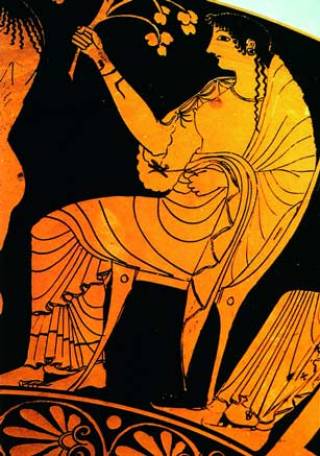 | Fig. 2: The surviving Late Helladic fortifications remains at the citadel of Mycenae, high-above and commanding the surrounding Argive plain. (Mykene, Qwqchris, CC BY-SA 3.0 <http://creativecommons.org/licenses/by-sa/3.0/>, via Wikimedia Commons) 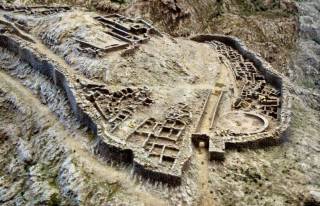 | Fig. 3: View of the Megaron at Mycenae, taken during the 1920–1923 excavations. (Mycenae: Megaron from the E., BSA SPHS 01/3338.C0614, British School at Athens) 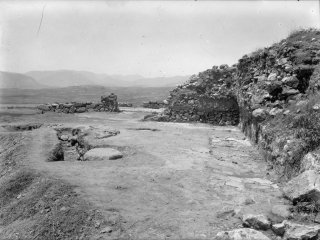 |
Fig. 4: Pages from the excavation notebook of Winifred Lamb, describing the start of work at Mycenae’s palace, and a sketch diagram of the whole area. (Winifred Lamb’s 1922 Notebook, MYC 1/2, British School at Athens) 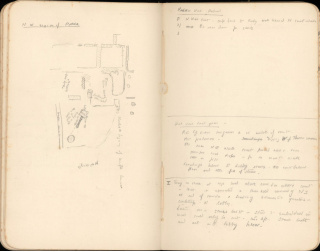 | Fig. 5: Pages from the excavation notebook of Winifred Lamb, describing the work on the hearth, and a sketch diagram of the whole area. (Winifred Lamb’s 1922 Notebook, MYC 1/2, British School at Athens) 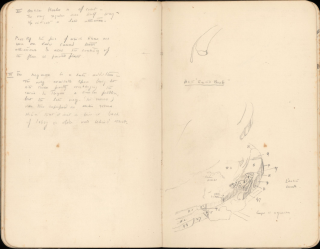 | Fig. 6: The eastern half of the hearth from the Mycenae megaron, taken during the 1920–1923 excavations. (Photograph of the Hearth at Megaron from the East, MYC 4/06/1, British School at Athens) 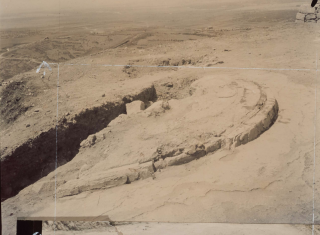 |
Fig. 7: Piet De Jong’s final drawing of the hearth in the megaron. Numbered labels refer to successive layers of painted stucco. (Drawing of the Hearth in Megaron, MYC 2/1/20, British School at Athens) 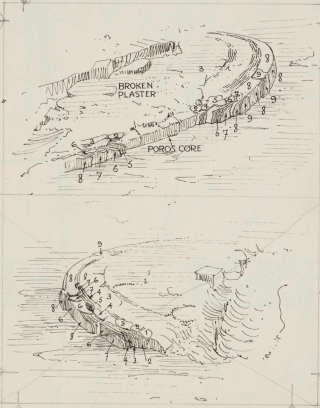 | Fig. 8: Watercolour drawing showing wave, stripe, and spiral patterns painted on successive layers of stucco from the hearth. (Various Patterns Painted on Stucco of the Hearth, MYC 3/2/30, British School at Athens) 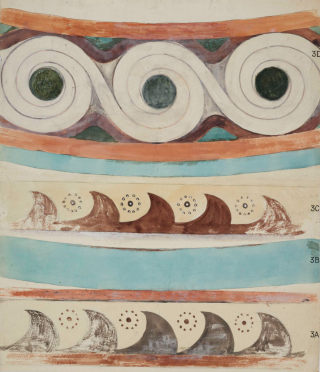 | Fig. 9: Watercolour drawings showing painted stucco from or near the Palace Megaron: wave patterns: hearth, first, second, fifth, sixth layers. (Painted Stucco from Hearth in the Palace Megaron, MYC 3/2/37, British School at Athens) 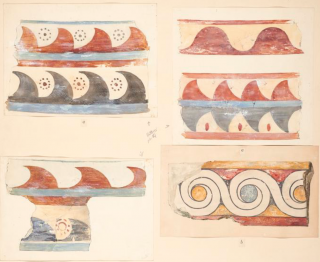 |
 Close
Close


